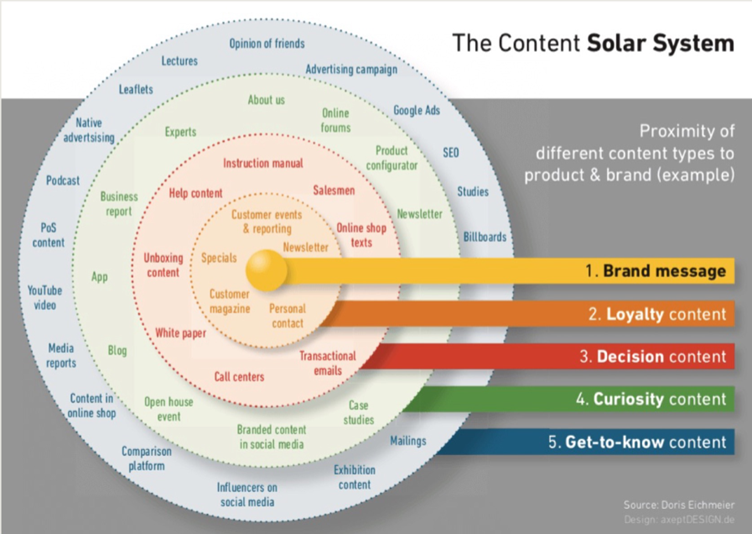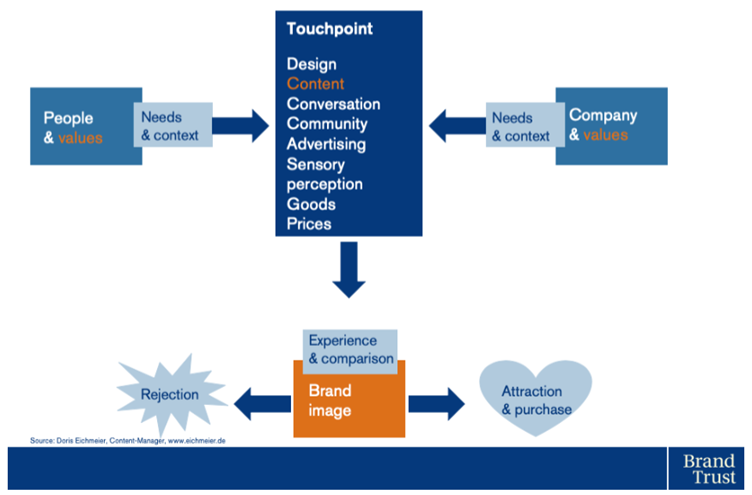It is not only the content that counts. Your brand is the sun around which your entire content world revolves.
Everyone knows brands – be it from working experience or from simply skimming through the shelves in a shop, searching for that one specific product you always buy. But how come people and companies alike are so attached to brands? Content Strategist Doris Eichmaier has several explanations.
What is the brand? #
A brand is the condensed representation of excellence, capturing the core of a company or product in a single expression. It brings together all the key ideas strategically linked to a brand name or logo, aiming to evoke specific perceptions and emotions in consumers.
According to Professor Dr. Christoph Burmann, Chair of Innovative Brand Management, "a brand is a comprehensive entity that goes beyond a mere label; it is the cumulative impact of ideas intended to distinguish the offerings of one company from those of its competitors." By carefully creating and managing these connections, a brand not only communicates the quality and uniqueness of its products but also establishes a clear identity that resonates with consumers, building lasting connections and loyalty.
Brand values shape the content of oatly #
To avoid monotony and capture attention, your content must be both unique and outstanding, otherwise, it runs the risk of being perceived as dull. The key to achieving this lies in the simplicity of utilizing your brand values – they provide the foundation for crafting compelling and distinctive content that resonates with your audience.
There exists a perfect example of bringing the brand values to its consumers - Oatly.
Oatly strategically communicates multiple goals across diverse channels, embodying a message architecture that revolves around sustainability, health, a rebellious anti-cow milk stance, and a playful, chaotic attitude. Oatly is committed to sustainability and shows ongoing efforts to challenge norms and promote sustainability in unexpected ways, aligning with Oatly's message architecture. For example, Oatly comes up with creative ad campaigns against cow’s milk or designs its packages with chaotic fonts while at the same time highlighting its sustainability and making its CO2 emissions public.
The content solar system
Everything Oatly does works so well because they treat the brand as the sun of their content world and give the brand a leading role. Brands that do that have a great understanding of their Content Solar System. Let’s dive deeper into it and find out what that means. The Content Solar System is a revolutionary framework for strategizing content around the customer journey.
In this model, shown as circles with a central "sun" the brand's core values radiate from the center outwards, forming different layers of content tailored to customer engagement stages. The content solar system looks different for every brand and every brand needs to build it for themselves. The model for a fridge brand can for example look like this: The innermost circle focuses on the powerful and transactional "Brand Message," including things like instruction manuals and sales pitches. Moving outwards, "Loyalty Content" nurtures post-purchase relationships through newsletters and personal contacts. The third layer, "Decision Content," influences purchasing choices with detailed information and comparisons. "Curiosity Content" engages potential customers with blog posts and webinars, while the outermost layer, "Get-to-Know Content," uses influencers and advertising to reach a broader audience unfamiliar with the brand.
In essence, this model serves as a celestial guide for marketers, helping them to align content with the customer journey, from acquisition to retention. But – and here is the important part – customer journeys are no longer considered to move from one stage to another. Potential customers get in contact with the brand everywhere and jump from phase to phase. In order to gain a loyal customer the brand message has to be the same in every piece of content. Treating the brand as the sun of the content world gives uniqueness and power to your content, to all formats, to all stakeholders and to all touchpoints with (potential) customers.

How content and brand image connects
With all information about the Content Solar System it is now clear that the content buys into the brand image and makes the brand recognizable. But how exactly does that work? The process involves two key players – the company and the people – each driven by their values and needs. The company generates diverse information, encompassing design, community building, conversations, prices, goods, advertising and so on. These elements serve as touchpoints, with content being a significant one. When individuals encounter this content, they compare their own values and needs with those communicated by the company.
The outcome of this comparison, coupled with people's experiences with the company, molds the brand image. Over time, with repeated exposure to the company's content, individuals decide whether the brand aligns with their values and needs. A clear brand message and the brand's central role in content creation are essential for establishing a distinct brand image, influencing people to become customers or, if the fit is not right, leading to their rejection of the company.

Exercise: How to discover your brand’s perception
Now that was a lot of input about brands, their meaning and their power. All this knowledge will prove valuable for the company. However, it’s understandable, if you are overwhelmed with information right now. Your head might be spinning, and you are asking yourself: “How can I identify how well my brand is doing right now?”
Exploring your brand’s impact could entail pricey questionnaires and studies. But fear not! What if there was an easier way to get a quick assessment of your brand’s current perception. From the inside as well as from the outside.
If that sounds tempting to you, then you should definitely keep reading!
For this exercise you need a small group. A size of approximately 10 people works best. It is important that ideally all but one person know close to nothing about the brand you are going to discuss. You will also need a website or another public medium of a brand to analyze. The person of the company will usually provide this.
Now it is time to split up the group into two roles: the interviewers and the analysts. The person of the company will be the interviewee. The interviews will stay with the interviewee and ask them questions about their company’s brand. The analysts will take a close look at the medium at hand. The two groups will work in separate rooms. It is important that they do not hear each other’s input for now.
Take your time for this step. The interview and analysis can last around 30 minutes or longer of course, if needed.
That is all great but what exactly should you inquire or research? Here is a selection of questions for the company’s interviewee, defined by content strategist Doris Eichmeier:
- What is special about your company in general, what values does it have? (This could include aspects like the product, employees, management, atmosphere, market position, etc.)
- How does your company differ from the competition?
- Describe the character that your company wants to express in three words.
The interviewers will also ask questions about what the given medium is trying to achieve. Here are some ideas for questions:
- What image does your company want to express?
- What details do you use to make this image clear?
- Where do you see potential for improvement?
Meanwhile, the analysts will immerse themselves from an outsider’s point of view into the company’s medium. They will take a close look at the content, imagery and overall feeling. These are the questions they could use as a guideline for their analysis:
- What could be special about this company?
- How does it differ from the competition?
- What three words could describe the character of this company?
- On which details do you recognize the character of the company?
- Do you have ideas for improvement?
As you can see the question the company’s internal person is asked, as well as the questions the external analysts ask themselves are very similar. This makes it possible to easily visualize how the brand’s perception can differ between what is intended to be portrayed and what is actually portrayed and seen by the audience.
After the individual group’s research, everyone gathers back in a single room and discusses their findings. An easy way is first for the analysts to present the medium with the findings and the flaws they may have noticed. Afterwards the interviewers will talk about what they learned about the brand’s company. Together with the analysts, the company’s person will be able to deduce new learnings and improvements for their brand’s perception.
An example for a conclusion that could be reached is: Company A stated that its strength is organic FairTrade fashion. They want to be creative, sustainable and trendy. However, an analysis of the website concluded that the audience needs to scroll through several pages until they find out that the products are organic and fair-produced. This means a core value of the brand is hidden and leaves potential customers in confusion. A quick fix could then be to add the FairTrade and organic cotton labels to the homepage.
As you can see, with this exercise that barely even takes an afternoon, you can gather valuable new knowledge about your brand.
Time to shine!
Now you do not just know a lot more about the value of your brand for your company and content. You also have been introduced to a quick way to discover how your brand is perceived. This has been enough theoretical input - now it’s your turn! It’s time to make your brand shine like the brightest sun out there!
Where to go from here #
You can find more about Brand values and Content Strategy here.
References #
Laferte, S. (2022, June 7). Style Guide: How To Write One for Your Brand. Content Marketing Institute. https://contentmarketinginstitute.com/articles/how-to-brand-style-guide/?
Rose, R. (2022, May 27). Do You Really Need To Measure Your Content’s Impact on Brand Value? [Rose-Colored Glasses]. Content Marketing Institute.
https://contentmarketinginstitute.com/articles/measure-brand-value
Eichmeier, D. (2019, October 21). Brand and content: a love story. Brand Trust.
https://www.brand-trust.de/en/article/2019/brand-content-lovestory.php (Eichmeier, 2021)
This article is based on a lecture held on December 15th, 2023 during the preparation for the "Content Analysis" project work in the first semester of the Master's programm "Content Strategy". This article was approved by Doris Eichmeier.

